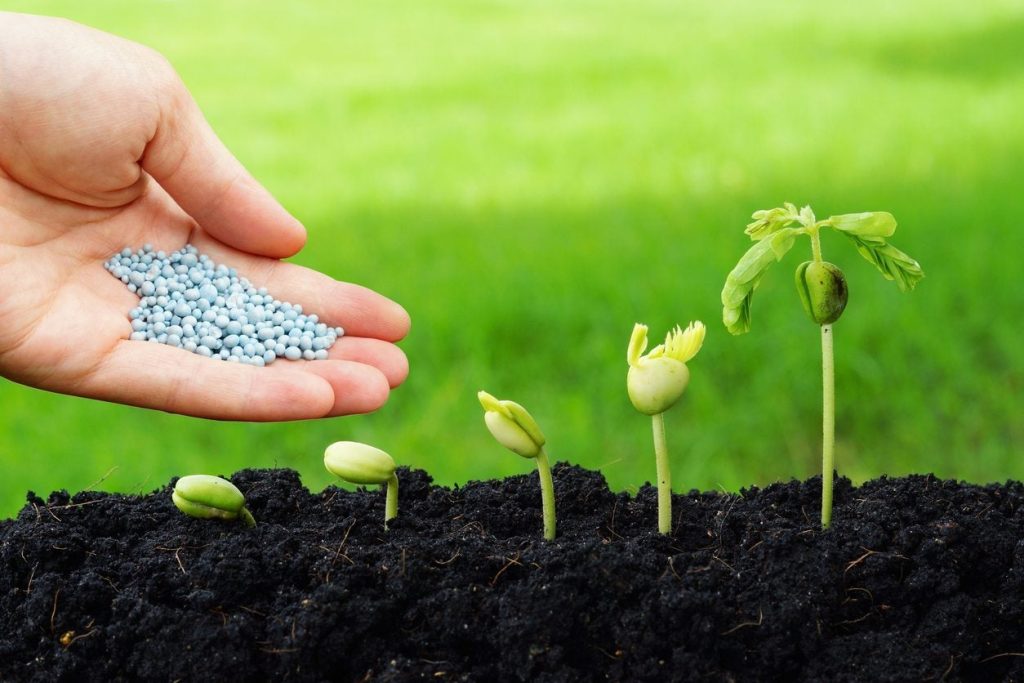After a long winter, many of us anxiously wait to get our hands in the soil and start planting. Whether you’re a first-time gardener or an experienced green thumb, it’s important to know how to fertilize your seedlings correctly to thrive and bear fruit (or vegetables, in this case).
This guide will provide everything you need to know about fertilizing your seedlings, from what type of fertilizer to use to when and how to apply it.
What is seedling fertilization?

Not all types of soil are fertile and in many cases plants do not get adequate nutrition from the soil. So to boost them, some extra soil needs to be amended. In that case, seedling fertilization plays a significant role.
Usually, seedling fertilization is the process of adding nutrients to the seed before or after planting in order to promote germination and growth.
The type and amount of nutrients you will provide, will depend on the species of plant and the stage of growth that the seedling is in.
Fertilizers can come in the form of organic or synthetic materials and can be administered through various methods, including irrigation, drenching, or foliar feeding.
You may also like: Non Cruciferous Vegetables List
Types of fertilizer:
Following are three types of fertilizers:
- Organic fertilizers are derived from natural materials. They are slow-release, providing a steady stream of nutrients over time. The best organic fertilizer for seedlings include Cow manure, Compost, Kelp, Limestone, Chicken Litter, Vermicomposting etc.
- Inorganic fertilizers are synthetic materials, such as ammonium nitrate or superphosphate. They are fast-acting, providing an immediate boost of nutrients to plants.
- Synthetic fertilizers balance organic and inorganic materials, providing a mix of fast- and slow-release nutrients.
How to fertilize your seedlings: Step by Step Guideline
Starting a garden from scratch can be a daunting task, but it doesn’t have to be. If you’re new to gardening, start by planting seeds indoors. This will allow you to get comfortable with the process before you plant your garden outdoors.
There are a few ways to prepare your garden soil for planting. You can loosen the soil with a shovel or hoe, add a layer of organic matter, such as compost, manure, or peat moss, and then mix everything.
You can also dig a hole, put the organic matter in the bottom, and then put the soil back in on top. When it comes time to plant your seeds, make sure you use the right soil and fertilizer. Follow these steps to fertilize your seedlings:
Step 1: Loosen the soil with a shovel or hoe
You will find different ways to loosen the soil in your garden. You can use a shovel or hoe to break up the soil.
This will help to aerate it and make it easier for your plants to grow. Another way to loosen the soil is to use a rake. A rake will help to smooth out the soil and get rid of any rocks or debris.
Step 2: Add a layer of organic matter
Adding organic matter to the soil is essential for a healthy garden. The organic matter will help to feed the plants, improve the soil structure, and increase the soil’s ability to hold water.
There are many different ways to add organic matter to the soil. You can use compost, manure, or peat moss. Each of these materials has its own benefits and drawbacks.
Compost is made from decomposed organic materials, such as leaves, grass clippings, and food scraps. It is a great way to add nutrients to the soil. Compost also helps to improve the soil structure quickly.
Step 3: Spread a layer of fertilizer over the organic matter
One of the most important aspects of organic gardening is adding fertilizer to the soil. The type of fertilizer you use will depend on the soil you have and the plants you are growing. In general, you should spread a layer of fertilizer over the organic matter before planting.
There are a few different types of fertilizers that can be used on organic matter, but the most important factor is making sure that the fertilizer is organic.
Spread a layer of fertilizer over the organic matter, then mix it with the topsoil using a rake. Doing this will help to break down the organic matter and release its nutrients into the soil.
Step 4: Dig a hole twice as deep as the pot and water it regularly
Dig a hole twice as deep as the pot and three times as wide. It’s important to give your plants the space they need to grow.
Digging a hole twice as deep and three times as wide will give your plants plenty of growing space. Place the pot in the hole and fill in the sides with soil, tamping it down as you go.
Finally, after completing all the processes accordingly, you need to water them regularly and grow fast.
You may also like:
Why fertilize your seedings?

Seeding needs fertilizer full with Nitrogen, Phosphorus, and potassium.
As most soil does not contain proper N-P-K level, you need to additionally fertilize the soil during seeding.
- Nitrogen fertilizer is mandatory for any new seed growth. You probably know that all soil does not contain proper nitrogen. NItrogen is water soluble and wash away easily (through rain, flood, microbes,or heavy watering).
- Like nitrogen, phosphorus fertilizer also does not present in most soils due to microbes activity, pH change and over temperature. However, why do you need to add phosphorus while seeding? because it helps to better rooth development with boosting energy elsewhere the seed needs during the growth (leaves, flowers).
- Potassium fertilizer helps to wheel distribute the water/nutrients/carbohydrates into all areas of the seed/plants. If you are sowing at an insect or pests prone area, you must need potassium. It will help your seed to survive pests as well as other associated diseases.
When to fertilize your seedlings:
The time you fertilize the plants depends on the type of plant, the type of soil, and the climate.There are three main times to fertilize your seedlings:
- When you plant them
- When they start to grow their first leaves, and
- When they start to flower.
However, once most of the seedlings become 3 inches taller, you can start fertilizing those. The time of fertilizing could be per week. till you are transplanting all the seedlings.
Frequently-asked questions (FAQs):
What is the best fertilizer for seedlings?
Obviously an all purpose fertilizer is the best fertilizer for the seedlings. You might know,all purpose fertilizers are water soluble, contain all nutrients, minerals with humic acid like organic agents.
Why do we need to care for seedlings?
Seeds are the foundation of our food system and the source of all plant life. When you take care of your seeds, you take care of the planet.
By supporting seed sovereignty and investing in organic seed production, we can create a future where healthy food is available for everyone and the planet is restored.
Conclusion:
In order to properly fertilize your seedlings, you need to understand a bit about the nutrient needs of plants and the different types of fertilizers available.
You can ensure that your seedlings get off to a healthy start and are well-prepared for a green life in your garden by following the guidelines.





